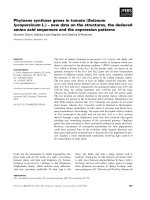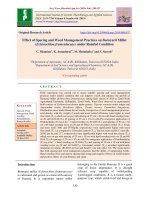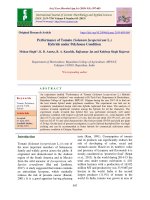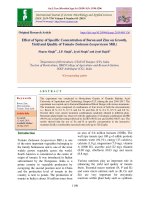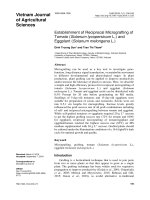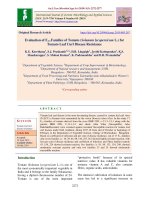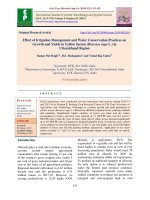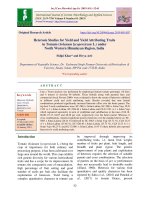Influence of different irrigation methods and water salinity levels on tomato (Solanum lycopersicum) growth under vertisols of Tungabhadra project command
Bạn đang xem bản rút gọn của tài liệu. Xem và tải ngay bản đầy đủ của tài liệu tại đây (371.69 KB, 11 trang )
Int.J.Curr.Microbiol.App.Sci (2019) 8(8): 2566-2576
International Journal of Current Microbiology and Applied Sciences
ISSN: 2319-7706 Volume 8 Number 08 (2019)
Journal homepage:
Original Research Article
/>
Influence of Different Irrigation Methods and Water Salinity Levels on
Tomato (Solanum lycopersicum) Growth under Vertisols of
Tungabhadra Project Command
R.H. Rajkumar1*, M. Nemichandrappa1, T. Anilkumar Dandekar1,
M.S. Ayyanagowdar2, B.S. Polisgowdar2, Satyanarayana Rao3 and J. Vishwanatha4
1
2
Department of Soil and Water Engineering, CAE, UAS, Raichur, India
Department of Irrigation and Drainage Engineering, CAE, UAS, Raichur, India
3
Main Agricultural Research Station, UAS, Raichur, India
4
AICRP on Saline water scheme, A.R.S, Gangavathi, UAS Raichur, India
*Corresponding author
ABSTRACT
Keywords
Tomato, Subsurface
drip, Surface drip,
Plant height,
Branches, Salinity
Article Info
Accepted:
22 July 2019
Available Online:
10 August 2019
The field experiment was carried out at Agricultural Research station, Gangavathi
(Karnataka), during 2018-19 and 2019-20 to study the influence of M0–furrow, M1–surface
drip and M2–subsurface drip irrigation techniques and irrigation salinity levels of S 0–0.65
dS m-1 (normal water), S1–2 dS m-1, S2–3 dS m-1, S3–4 dS m-1 and S4–5 dS m-1 on tomato
(Solanum lycopersicum) growth parameters under Vertisols of Tungabhadra Project
Command. During two years, the growth attributes such as plants per treatments, plant
height during 30, 60, 90 and 120 days after transplanting (DAT), number of branches per
plant during 30, 60, 90 and 120 DAT, number of fruits were significantly influenced by the
different irrigation techniques and different irrigation saline water levels. The maximum
number of plants per treatments, plant height and number of branches per plant during 30,
60, 90 and 120 DAT were recorded higher under subsurface and surface drip as compared
to furrow irrigation except plant height during 30 DAT. Similarly, under different
irrigation saline water levels, maximum number of plants, plant height and branches were
recorded under 0.65 dS m-1 and 2 dS m-1 treatment and least was recorded in 5 dS m-1
treatment. From the study it was concluded that the growth of tomato was good under
subsurface drip and surface drip as compared to furrow irrigation under main treatments
and under sub treatments, 0.65 and 2 dS m-1 treatments performed better as compared to
higher salinity levels. Whenever there is shortage of fresh water, saline water upto 2 dS m-1
can be used to grow tomato without much effect on the crop growth.
Introduction
The world’s oceans may seem unbounded, the
amount of fresh water virtually available to
the mankind is the most finite. The fresh
water is about 2.5 per cent (3.5 crore km3) of
the total global waters which is distributed in
glaciers and snow lakes (69%), lake and
rivers (0.3%). The salt water is about 97.5 per
cent (136.5 crore km3) of which 0.7% in the
form of soil moisture and 30% as ground
water. Human use of fresh water has
2566
Int.J.Curr.Microbiol.App.Sci (2019) 8(8): 2566-2576
increased more than 35 fold over the past
three centuries. The inland saline water has
now great potential for the use in irrigation
which the application of the adaptable water
use technologies as a non conventional water
resource (Gleick, 1993). Saline water
irrigation is practiced in several regions of the
world (Rhoades et al, 1992), where water
scarcity prevents the use of freshwater for
irrigation. Poor quality water constitutes 3284% of ground water surveyed in different
parts of India is related either saline or alkali
(Minhas, 1996).
If saline water is skillfully used for irrigation,
it can be beneficial for agricultural
production, particularly in fruits and
vegetables. The successful use of low quality
water requires the selection of salt tolerant
crops, and the application of a suitable water
management strategy. There is a necessity of
development of proper irrigation management
practices like drip irrigation techniques, so
that poor quality saline water can be used
with minimum adverse effect on crop yield.
Surface drip irrigation (SD) and subsurface
drip irrigation (SDI) methods can be very
effective in applying irrigation without leaf
wetting.
Of course, more advanced irrigation
technologies such as SDI can offer greater
achievable irrigation application efficiency
and distribution uniformity. In SDI, small
amount of water is applied to the soil through
the drippers placed below the soil surface
with discharge rates same as surface drip
irrigation. Subsurface drip irrigation helps in
reducing the evaporation loss, very little
interference with cultivation or cultural
practices, possible increase in longevity of
laterals and drippers, increases water use
efficiency, saves labour and water saving of
up to 30-70%. It can also be used in hilly
regions and on saline or alkali soils (Mane et
al., 2008).
During the last few years, irrigated tomato has
been expanding rapidly in the semi-arid part
of Karnataka around shallow to deep wells
having a salinity of more than 2 dS m-1 with
normal irrigation methods. This leading to
land becomes more prone to the salt affected.
Tomato is considered moderately sensitive to
salt stress, since it can tolerate an ECe (EC of
the saturated soil extract) of about 2.5 dS m-1
and fruit yield decrease by 10% with each
unit of ECe increasing above the threshold
value (Maas, 1986; FAO, 2005). Campos et
al., (2006) stated that the maximum soil
salinity level tolerated by tomato is 2.5 dS m1
, without reduction in the growth. However,
there is no much information available on the
effect of different irrigation techniques under
saline water growth of tomato crop in
Vertisols under TBP command area.
Therefore to see the influence of different
irrigation methods and use of different saline
water levels on growth of tomato, a study has
been conducted.
Materials and Methods
Description of study area
The experiment was carried out at
Agricultural Research Station (A.R.S),
Gangavathi. The site is located in Koppal
district of Karnataka state of India and falls in
the Northern Dry Zone viz., Zone-III of agro
ecological region 6 in the state. The field’s
location corresponds to 150 27' 22.15'' N
latitude and 760 31' 54.83'' E longitudes with
elevation of 423.17 m above mean sea level
(msl). According to the data at Meteorological
Department of the A.R.S, Gangavathi, the
mean annual rainfall based on 38 years record
(1979-2015) is 530.9 mm (Anon., 2017).
Although, monsoonal climate sets in early
June, rains during September-October (Northeast) are more assured in this region.
Normally dry weather prevails over entire
summer months with hottest period observed
2567
Int.J.Curr.Microbiol.App.Sci (2019) 8(8): 2566-2576
during April-May. During the first year of
study period, the total rainfall was 112.1 mm
and out of it, 107.9 mm was in the month of
May, 2018 and during second season, the total
rainfall was only 13.2 mm (3.6 mm in January
and 9.6 mm in February month, 2019). The
maximum open pan evaporation of 6.0 mm
day-1 was recorded in the months of March,
2018 and April, 2018 with the minimum
evaporation of 0.9 mm day-1 in the month of
January, 2018. During second year, the
maximum open pan evaporation of 6.0 mm
day-1 was recorded in the month of April,
2018 and the minimum evaporation of 1.0
mm day-1 in the month of December, January,
February and March, 2019.
The texture of the soil was determined by
international pipette method. The soils texture
of the study area is classified as clay with
33.6 per cent sand, 22.6 per cent silt and 43.8
per cent clay at 0-30 cm depths, 25.1 per cent
sand, 27.6 per cent silt and 47.3 per cent clay
at 30-60 cm depths and 17.5 per cent sand,
27.2 per cent and 55.3 per cent clay at 60-90
cm depths. The density of soil was found to
be 1.26, 1.25 and 1.23 g cm-3 at 0-30, 30-60
and 60-90 cm depths respectively. The
irrigation water used for experiment was from
irrigation pond water, where water was stored
through the field channels of seventeen
distributory, left bank canal of TBP command.
This water was analyzed for pH and EC and
was found to be 7.10 and 0.65 dS m-1
respectively.
The three different irrigation techniques and
five different saline levels of irrigation water
were kept as main and sub treatments
respectively. The main treatments were M0–
Furrow irrigation, M1–Surface drip irrigation
and M2–Subsurface drip irrigation and sub
treatments were S0–Normal (0.65 dS m−1)
water, S1–2 dS m−1, S2–3 dS m−1, S3–4 dS m−1
and S4–5 dS m−1. Four water tanks (2, 3, 4
and 5 dS m-1) of 2000 liter capacity and one
tank (normal water i.e. 0.65 dS m-1) with a
capacity of 2500 liter were installed on 8.0
(L) x 2.4 (W) m cement concrete platform.
The filtered water was connected to five water
tanks with separate control valves for filling.
After filling up the tanks, a known quantity of
sodium chloride (NaCl) was calculated and
added (Soria and Cuartero, 1998) to get
desired ECiw of saline water of 2, 3, 4 and 5
dS m-1 as per the calculation procedure given
by Bibha Rani and Sharma (2015). Every
time after adding NaCl to the tanks, the
irrigation water was thoroughly mixed. Under
subsurface drip treatment, drip laterals were
buried at a depth of 20 cm below the ground.
The Tomato nursery plants were sown with
plant to plant and row to row distance of 0.4
and 1.2 m respectively. To meet the nutrient
requirement and as per the recommended
dose of fertilizer, the nitrogen, phosphorus
and potassium at the rate 250:250:250 kg ha-1
were supplied from the different fertilizers
through manually for furrow irrigated plots
and the water soluble fertilizers like Urea,
19:19:19, KNO3 and CaNO3 were applied in
splits through irrigation using fertilizer
injection system (Venturi) for drip irrigated
treatments at different growth stages. All
agronomic practices except method of
irrigation and application of fertilizer were
kept same in all treatments. Manual weeding
was done two times during the crop cycle.
Tomato growth attributes
The different observations were recorded
during growth period of tomato crop for two
years (Two seasons). After one month, a well
established tomato plants were counted and
noted for all the treatments to know the
influence of different treatments on plant
population. Plant height was recorded at
intervals of 30, 60, 90 and 120 days after
transplanting (DAT). Height was measured
from the base of the plant to the top of the
2568
Int.J.Curr.Microbiol.App.Sci (2019) 8(8): 2566-2576
plant with the help of meter scale. Five plants
were tagged at random in each treatment for
recording the number of branches at an
interval of 30 days from the date of
transplanting. Number of branches per plant
was counted at 30, 60, 90 and 120 DAT.
Average number of branches was calculated.
Total number of fruits per plant was recorded
from each tagged plants during every picking.
After the final harvest, the numbers of fruit
picked from individual plots were totaled.
Results and Discussion
Every time after filling up of the water tanks,
a known quantity of salt (NaCl) were added to
obtain desire level of salinity and different
saline water was applied through furrow,
surface drip and subsurface drip irrigation
methods to different treatments. The results of
growth parameters of tomato which are
influenced by different irrigation techniques
and saline water levels were discussed below
Number of established plants
During first season, among different irrigation
techniques, significantly higher established
plants were observed in M2 (36.6) treatment
followed by M1 (36.47) and least in M0
(35.33). In different irrigation water salinity
levels, significantly higher plants were
observed in S0 (37.11) followed by S1 (36.89)
and least in case of S4 (34.33).
Interaction effect showed no significant
effect. During second season of the crop,
significantly higher established plants were
observed in M2 (36.53) treatment followed by
M1 (36.40) and least in M0 (35.33). In
different irrigation water salinity levels,
significantly higher plants were observed in
S0 (37.33) followed by S1 (37.22) and least in
case of S4 (34.0). Interaction effect found to
be non significant (Table 1).
Plant height
In general, height of the plants across the
growth stages showed increasing trend
irrespective of irrigation technique and
irrigation saline water levels (Table 2 and 3)
in both the season. The pooled data of two
season shows that at 30, 60, 90 and 120 DAT,
M2 (55.45, 84.42, 106.94 and 111.03 cm
respectively) recorded significantly higher
plant height followed by M1 (54.37, 82.71,
105.97 and 110.51 cm respectively) and least
in case of M0 (50.41, 75.50, 98.94 and 100.29
cm respectively). Among irrigation salinity
levels, height of the plant varied significantly
at all four stages of the crop. The treatment S0
recorded significantly higher plant height
(58.31, 85.66, 112.25 and 116.13 cm
respectively) followed by S1 (56.78, 83.73,
111.61 and 115.5 cm respectively) and least
in case of S4 (47.62, 74.28, 88.81 and 95.45
cm, respectively). The highest salinity levels
of irrigation reduced the plant height as
compared to normal water. The above
findings were in proximity with Malash et al.,
2005. The interaction effect found to be non
significant (Table 2 and 3).
Number of branches per plant
The pooled data of two season indicates that
at 30, 60, 90 and 120 DAT, M2 recorded
significantly higher branches (7.2, 11.71,
15.53 and 17.47 per plant, respectively)
followed by M1 (7.16, 11.57, 14.98 and 17.25
per plant respectively) and least in case of M0
(6.62, 10.41, 12.76 and 14.54 per plant
respectively). Among irrigation salinity
levels, yield levels, number of branches
varied significantly at all four stages of the
crop. The treatment S0 recorded significantly
higher branches (7.94, 12.64, 15.97 and 18.23
respectively) followed by S1 (7.71, 12.18,
15.86 and 18.1 respectively) and least in case
of S4 (5.96, 9.99, 12.78 and 14.57 per plant,
respectively). The interaction effect found to
be non significant (Table 4 and 5).
2569
Int.J.Curr.Microbiol.App.Sci (2019) 8(8): 2566-2576
Table.1 Number of established plants per treatment and number of fruits as influenced by
different irrigation techniques and saline water
Treatment details
Number of plants per treatment
2018
2019
Pooled
Irrigation techniques (M)
35.33
35.33
35.33
M0
36.47
36.40
36.43
M1
36.60
36.53
36.57
M2
SE m +
0.04
0.05
0.04
C.D (p=0.05)
0.11
0.15
0.11
Irrigation saline water levels (S)
37.11
37.33
37.22
S0
36.89
37.22
37.06
S1
36.44
36.22
36.33
S2
35.89
35.67
35.78
S3
34.33
34.00
34.17
S4
SE m +
0.07
0.09
0.08
C.D (p=0.05)
0.21
0.26
0.23
Interaction (MxS)
36.67
36.67
36.67
M0 S0
35.67
36.00
35.83
M0 S1
35.67
35.67
35.67
M0 S2
35.00
35.00
35.00
M0 S3
33.67
33.33
33.50
M0 S4
37.00
37.33
37.17
M1 S0
37.33
37.67
37.50
M1 S1
36.67
36.33
36.50
M1 S2
36.67
36.33
36.50
M1 S3
34.67
34.33
34.50
M1 S4
37.67
38.00
37.83
M2 S0
37.67
38.00
37.83
M2 S1
37.00
36.67
36.83
M2 S2
36.00
35.67
35.83
M2 S3
34.67
34.33
34.50
M2 S4
SE m +
0.22
0.27
0.24
C.D (p=0.05)
NS
NS
NS
Note:
M0: Furrow Irrigation
S0: Normal water (ECiw=0.65 dS m-1)
S3: ECiw=4.0 dS m-1
Number of fruits per plant
2018
2019
Pooled
47.20
58.47
59.20
0.32
0.94
45.73
57.40
58.13
0.37
1.07
46.47
57.93
58.67
0.26
0.75
62.11
60.89
54.44
52.56
44.78
0.47
1.35
61.11
59.78
53.67
51.22
43.00
0.71
2.04
61.61
60.33
54.06
51.89
43.89
0.52
1.49
53.00
51.67
49.33
45.33
36.67
66.33
65.33
56.33
56.00
48.33
67.00
65.67
57.67
56.33
49.33
1.41
NS
52.00
50.33
47.67
44.00
34.67
65.33
64.33
56.33
54.33
46.67
66.00
64.67
57.00
55.33
47.67
2.12
NS
52.50
51.00
48.50
44.67
35.67
65.83
64.83
56.33
55.17
47.50
66.50
65.17
57.33
55.83
48.50
1.55
NS
M1: Surface drip
S1: ECiw=2.0 dS m-1
S4: ECiw=5.0 dS m-1
2570
M2: Subsurface drip
S2: ECiw=3.0 dS m-1
Int.J.Curr.Microbiol.App.Sci (2019) 8(8): 2566-2576
Table.2 Average plant height of tomato as influenced by different irrigation techniques
and saline water during 30 and 60 DAT
Treatment details
Average plant height (cm) -30
DAT
2018
2019
Pooled
Irrigation techniques (M)
51.20
49.61
50.41
M0
55.40
53.33
54.37
M1
56.17
54.73
55.45
M2
SE m +
0.38
0.38
0.36
C.D (p=0.05)
NS
NS
NS
Irrigation saline water levels (S)
58.82
57.80
58.31
S0
57.26
56.31
56.78
S1
54.59
52.51
53.55
S2
51.67
49.88
50.77
S3
48.94
46.30
47.62
S4
SE m +
0.62
0.75
0.68
C.D (p=0.05)
1.79
2.17
1.96
Interaction (MxS)
58.93
57.00
57.97
M0 S0
56.47
55.67
56.07
M0 S1
48.27
47.07
47.67
M0 S2
47.20
45.87
46.53
M0 S3
45.13
42.47
43.80
M0 S4
58.03
57.23
57.63
M1 S0
57.00
56.40
56.70
M1 S1
58.87
55.17
57.02
M1 S2
53.10
50.80
51.95
M1 S3
50.00
47.07
48.53
M1 S4
59.50
59.17
59.33
M2 S0
58.30
56.87
57.58
M2 S1
56.63
55.30
55.97
M2 S2
54.70
52.97
53.83
M2 S3
51.70
49.37
50.53
M2 S4
SE m +
1.87
2.26
2.04
C.D (p=0.05)
NS
NS
NS
Note:
M0: Furrow Irrigation
S0: Normal water (ECiw=0.65 dS m-1)
S3: ECiw=4.0 dS m-1
Average plant height (cm)-60
DAT
2018
2019
Pooled
79.33
84.36
85.61
0.31
0.90
71.67
81.06
83.23
0.59
1.69
75.50
82.71
84.42
0.43
1.23
87.53
85.49
84.72
80.93
76.83
0.62
1.79
83.78
81.98
78.53
77.23
71.73
0.93
2.68
85.66
83.73
81.63
79.08
74.28
0.72
2.07
84.93
82.07
81.63
78.00
70.03
88.67
87.00
85.40
81.27
79.47
89.00
87.40
87.13
83.53
81.00
1.87
NS
77.00
76.67
69.77
72.37
62.53
86.67
83.43
82.40
78.47
74.33
87.67
85.83
83.43
80.87
78.33
2.79
NS
80.97
79.37
75.70
75.18
66.28
87.67
85.22
83.90
79.87
76.90
88.33
86.62
85.28
82.20
79.67
2.15
NS
M1: Surface drip
S1: ECiw=2.0 dS m-1
S4: ECiw=5.0 dS m-1
2571
M2: Subsurface drip
S2: ECiw=3.0 dS m-1
Int.J.Curr.Microbiol.App.Sci (2019) 8(8): 2566-2576
Table.3 Average plant height of tomato as influenced by different irrigation techniques and
saline water during 90 and 120 DAT
Treatment details
Average plant height (cm)90 DAT
2018
2019
Pooled
Irrigation techniques (M)
98.87
99.01
98.94
M0
105.71
106.22
105.97
M1
106.66
107.21
106.94
M2
SE m +
0.40
0.42
0.37
C.D (p=0.05)
1.15
1.22
1.06
Irrigation saline water levels (S)
112.15
112.34
112.25
S0
111.22
112.00
111.61
S1
106.51
107.07
106.79
S2
99.80
100.77
100.28
S3
89.06
88.56
88.81
S4
SE m +
0.39
1.25
0.76
C.D (p=0.05)
1.14
3.59
2.19
Interaction (MxS)
109.57
108.33
108.95
M0 S0
108.97
109.33
109.15
M0 S1
101.23
102.17
101.70
M0 S2
92.57
93.67
93.12
M0 S3
82.03
81.53
81.78
M0 S4
112.97
114.70
113.83
M1 S0
112.07
114.00
113.03
M1 S1
108.27
108.33
108.30
M1 S2
102.93
103.73
103.33
M1 S3
92.33
90.33
91.33
M1 S4
113.93
114.00
113.97
M2 S0
112.63
112.67
112.65
M2 S1
110.03
110.70
110.37
M2 S2
103.90
104.90
104.40
M2 S3
92.80
93.80
93.30
M2 S4
SE m +
1.18
3.74
2.28
C.D (p=0.05)
NS
NS
NS
Note:
M0: Furrow Irrigation
S0: Normal water (ECiw=0.65 dS m-1)
S3: ECiw=4.0 dS m-1
Average plant height (cm) 120 DAT
2018
2019
Pooled
99.77
109.17
109.99
0.32
0.91
100.81
111.85
112.07
0.51
1.48
100.29
110.51
111.03
0.32
0.93
115.64
114.78
107.19
100.27
93.68
0.48
1.38
116.61
116.23
109.80
101.34
97.22
1.25
3.59
116.13
115.51
108.49
100.81
95.45
0.78
2.26
110.30
110.17
102.50
92.93
82.97
117.83
116.83
109.03
103.47
98.67
118.80
117.33
110.03
104.40
99.40
1.44
NS
111.33
111.37
103.07
94.60
83.67
118.33
118.33
112.33
103.93
106.33
120.17
119.00
114.00
105.50
101.67
3.74
NS
110.82
110.77
102.78
93.77
83.32
118.08
117.58
110.68
103.70
102.50
119.48
118.17
112.02
104.95
100.53
2.35
NS
M1: Surface drip
S1: ECiw=2.0 dS m-1
S4: ECiw=5.0 dS m-1
2572
M2: Subsurface drip
S2: ECiw=3.0 dS m-1
Int.J.Curr.Microbiol.App.Sci (2019) 8(8): 2566-2576
Table.4 Number of branches of tomato as influenced by different irrigation techniques and saline
water during 30 and 60 DAT
Treatment details
Number of branches-30 DAT
2018
2019
Pooled
Irrigation techniques (M)
6.54
6.70
6.62
M0
7.09
7.22
7.16
M1
7.13
7.28
7.20
M2
SE m +
0.03
0.03
0.03
C.D (p=0.05)
0.09
0.09
0.08
Irrigation saline water levels (S)
7.87
8.01
7.94
S0
7.64
7.78
7.71
S1
6.93
7.04
6.98
S2
6.26
6.47
6.37
S3
5.90
6.03
5.96
S4
SE m +
0.08
0.08
0.08
C.D (p=0.05)
0.23
0.23
0.22
Interaction (MxS)
7.52
7.68
7.60
M0 S0
7.31
7.44
7.37
M0 S1
6.69
6.75
6.72
M0 S2
5.60
5.91
5.76
M0 S3
5.57
5.70
5.63
M0 S4
8.03
8.13
8.08
M1 S0
7.75
7.88
7.82
M1 S1
7.05
7.20
7.12
M1 S2
6.60
6.76
6.68
M1 S3
6.03
6.11
6.07
M1 S4
8.05
8.20
8.13
M2 S0
7.87
8.01
7.94
M2 S1
7.05
7.16
7.11
M2 S2
6.57
6.75
6.66
M2 S3
6.10
6.27
6.18
M2 S4
SE m +
0.24
0.24
0.23
C.D (p=0.05)
NS
NS
NS
Note:
M0: Furrow Irrigation
S0: Normal water (ECiw=0.65 dS m-1)
S3: ECiw=4.0 dS m-1
Number of branches-60 DAT
2018
2019
Pooled
10.47
11.58
11.91
0.06
0.18
10.35
11.55
11.63
0.07
0.19
10.41
11.57
11.77
0.06
0.19
12.62
12.33
11.33
10.26
10.06
0.10
0.30
12.67
12.02
11.19
10.08
9.92
0.09
0.25
12.64
12.18
11.26
10.17
9.99
0.10
0.27
11.67
11.20
10.93
9.43
9.10
12.97
12.70
11.27
10.57
10.40
13.23
13.10
11.80
10.77
10.67
0.31
NS
11.83
11.00
10.80
9.17
8.97
13.10
12.80
11.10
10.48
10.27
13.07
12.27
11.68
10.60
10.53
0.26
NS
11.75
11.10
10.87
9.30
9.03
13.03
12.75
11.18
10.53
10.33
13.15
12.68
11.74
10.69
10.60
0.29
NS
M1: Surface drip
S1: ECiw=2.0 dS m-1
S4: ECiw=5.0 dS m-1
2573
M2: Subsurface drip
S2: ECiw=3.0 dS m-1
Int.J.Curr.Microbiol.App.Sci (2019) 8(8): 2566-2576
Table.5 Number of branches of tomato as influenced by different irrigation techniques and saline
water during 90 and 120 DAT
Treatment details
Number of branches-90 DAT
2018
2019
Pooled
Irrigation techniques (M)
12.79
12.72
12.76
M0
15.01
14.95
14.98
M1
15.55
15.51
15.53
M2
SE m +
0.14
0.14
0.14
C.D (p=0.05)
0.41
0.42
0.41
Irrigation saline water levels (S)
15.88
16.06
15.97
S0
15.82
15.89
15.86
S1
14.29
14.11
14.20
S2
13.34
13.26
13.30
S3
12.90
12.66
12.78
S4
SE m +
0.17
0.17
0.17
C.D (p=0.05)
0.50
0.49
0.49
Interaction (MxS)
13.58
13.92
13.75
M0 S0
13.47
13.50
13.48
M0 S1
13.33
13.13
13.23
M0 S2
11.97
11.77
11.87
M0 S3
11.60
11.30
11.45
M0 S4
16.63
16.80
16.72
M1 S0
16.60
16.77
16.68
M1 S1
14.47
14.27
14.37
M1 S2
13.83
13.73
13.78
M1 S3
13.50
13.17
13.33
M1 S4
17.43
17.47
17.45
M2 S0
17.40
17.40
17.40
M2 S1
15.07
14.93
15.00
M2 S2
14.23
14.27
14.25
M2 S3
13.60
13.50
13.55
M2 S4
SE m +
0.52
0.51
0.51
C.D (p=0.05)
NS
NS
NS
Note:
M0: Furrow Irrigation
S0: Normal water (ECiw=0.65 dS m-1)
S3: ECiw=4.0 dS m-1
Number of branches-120 DAT
2018
2019
Pooled
14.57
17.29
17.50
0.15
0.43
14.51
17.22
17.43
0.15
0.43
14.54
17.25
17.47
0.15
0.43
18.07
17.93
16.24
15.29
14.73
0.19
0.56
18.40
18.27
15.91
14.96
14.40
0.23
0.67
18.23
18.10
16.08
15.12
14.57
0.21
0.61
15.67
15.47
14.47
13.97
13.30
19.07
18.93
17.20
15.73
15.50
19.47
19.40
17.07
16.17
15.40
0.58
NS
16.00
15.80
14.13
13.63
12.97
19.40
19.27
16.87
15.40
15.17
19.80
19.73
16.73
15.83
15.07
0.70
NS
15.83
15.63
14.30
13.80
13.13
19.23
19.10
17.03
15.57
15.33
19.63
19.57
16.90
16.00
15.23
0.64
NS
M1: Surface drip
S1: ECiw=2.0 dS m-1
S4: ECiw=5.0 dS m-1
2574
M2: Subsurface drip
S2: ECiw=3.0 dS m-1
Int.J.Curr.Microbiol.App.Sci (2019) 8(8): 2566-2576
Number of fruits per plant
The pooled data of two season indicted that,
among irrigation techniques, significantly
higher number of fruits were counted in a
single plant in M2 (58.67) during entire
harvesting stage followed by M1 (57.93) but
lesser fruits in case of M0 (46.47). Among
irrigation saline water levels, significantly
higher fruits were counted in S0 (61.61)
followed by S1 (60.33) and least in case of S4
(43.89). No significant effect was found under
interaction (Table 1). Similar results were
obtained by Takase et al., 2010 and Malash et
al., 2005. The reduction of fruit number may
be due to reduction in flower number per
cluster (Malash et al., 2002).
It is concluded that in two seasons the growth
attributes such as plants per treatments, plant
height during 30, 60, 90 and 120 DAT,
number of branches per plant during 30, 60,
90 and 120 DAT, average single fruit and ten
fruits weight were significantly influenced by
the different irrigation techniques and
different irrigation saline water levels. The
maximum number of plants per treatments,
plant height and number of branches per plant
during 30, 60, 90 and 120 DAT were recorded
higher under subsurface and surface drip as
compared to furrow irrigation except plant
height during 30 DAT. Similarly, under
different irrigation saline water levels,
maximum number of plants, plant height and
branches were recorded under 0.65 dS m-1
and 2 dS m-1 treatment and least was recorded
in 5 dS m-1 treatment. Hence it is concluded
that whenever there is shortage of fresh water,
saline water upto 2 dS m-1 can be used to
grow tomato crop without much effect on the
growth parameter.
References
Anonymous, 2017, Ann. Rep. (2017-18).
Management of salt affected soil and
use of saline water in agriculture.
Weather data of A.R.S., Gangavathi.,
p.72.
Bibha Rani and Sharma, V. K., 2015,
Standardization of methodology for
obtaining the desired salt stress
environment
for
salinity
effect
observation in rice seedlings. Int. J. of
Environ. Sci.,6(2):232-236.
Campos, Carlos Alberto Brasiliano, Pedro
Dantas Fernandes, Hans Raj Gheyi,
Flavio Favaro Blanco, Cira Belem
Goncalves and Selma Aparecida
Ferreira Campos, 2006, Yield and fruit
quality of industrial tomato under saline
irrigation. Scientia Agricola, 63(2):4652.
Gleick, P. H., 1993, Water in crisis. A guide
to the world’s fresh water resources.
New York Oxford University Press. p.
473.
FAO, Field Guide, 2005. 20 things to know
about the impact of salt water on
agricultural land in aceh province. Field
Guide on Salinity in Aceh-Draft
publication RAP 05. pp. 1-7.
Maas, E. V., 1986, Salt tolerace of plants.
Appl. Agric. Res., 1:12-26.
Malash, N., Ghaibeh, A., Yoe, A., Ragab, R.
and Cuartero, J., 2002, Effect of water
salinity on yield and fruit quality of
tomato. Acta. Hort., 573: 423-434.
Malash, N., Flowers, T. J. and Ragab, R.,
2005, Effect of irrigation systems and
water management practices using
saline and non-saline water on tomato
production. Agril. Water Mgmt., 78(1–
2):25-38.
Mane, M. S, Ayare, B. L. and Magar, S. S.,
2008, Principles of drip irrigation
system. Jain Brothers publishers, New
Delhi. p. 191.
Minhas, P. S., 1996, Saline water
management for irrigation in India.
Agril. Water Mgmt., 30(1):1-24.
Rhodes, J. D., Kandiah, A. and Mashak, A.
2575
Int.J.Curr.Microbiol.App.Sci (2019) 8(8): 2566-2576
M., 1992, The use of saline waters for
crop production. Irrigation and
Drainage, p. 150.
Soria, T. and Cuartero, J., 1998, Tomato fruit
yield and water consumption with salty
water irrigation. Acta Horti., 45(8):1519.
Takase, M. J., Owusu-Sekyere, D. and SamAmoah, L. K., 2010, Effects of water of
different quality on tomato growth and
development. Asian J. of Plant Sci.,
9(6):380-384.
How to cite this article:
Rajkumar, R.H., M. Nemichandrappa, T. Anilkumar Dandekar, M.S. Ayyanagowdar, B.S.
Polisgowdar, Satyanarayana Rao and Vishwanatha, J. 2019. Influence of Different Irrigation
Methods and Water Salinity Levels on Tomato (Solanum lycopersicum) Growth under
Vertisols of Tungabhadra Project Command. Int.J.Curr.Microbiol.App.Sci. 8(08): 2566-2576.
doi: />
2576
